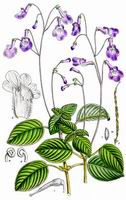
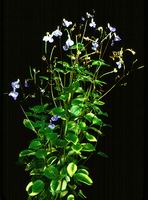
Left: Bot. Mag. t. 8150 (1907)
Right: cult. BG Vienna, phot. A. Weber (1979)
Full name and orig. publication: Streptocarpus Lindl., Bot. Reg. 14, t. 1173 (1 Sept. 1828).
Etymology: From the Greek στρεπτός, streptos = twisted, and καρπός, karpos = fruit, alluding to the twisted capsules.
Synonyms: -
Infrafamilial position: Didymocarpoid Gesneriaceae - "African and Madagascan genera” (Weber 2004).
Description: Annual, perennial or monocarpic herbs. Stem occasionally lignified; habit caulescent-erect or creeping, or acaulescent, rosulate or unifoliate. Leaves opposite, petiolate in the caulescent species (very rarely alternate and sessile, and then the flowering axis with a large basal leaf); in the acaulescent species the leaf shows continued growth from a basal meristem, evidenced by ther continuous formation of wide-spreading lateral veins and the frequent absence of an intact leaf apex. Cymes axillary, pedunculate; eventually displaced to the base of the lamina or emerging from the leaf-stalk; branching sometimes ± one-sided, many-, few- or (rarely) one-flowered. Sepals free to base, rarely connate in the lower part. Corolla tubular-bilabiate. Fertile stamens two, the anterior pair; filaments often thickened in the middle; anthers with divaricate (rarely parallel) thecae, usually cohering face to face; dehiscence lines apically confluent, lateral staminodes usually present, the posterior one often missing. Nectary annular or shortly cupular. Ovary ovoid to cylindrical, usually unilocular, sometimes apparently bilocular, ovules restricted to the recurved tips of placentae; stigma variable. Fruit a ± cylindric capsule, twisting spirally during development, dehiscing by a loculicidal slit and slight untwisting of the spiral, when old sometimes splitting into 4 valves. Seeds numerous, small, reticulate or verruculose.
Chromosome number: 2n = 30, 32, 64, 96, 128 (see Notes - subgenera).
Species number: C. 135.
Type species: Streptocarpus rexii Lindl.
Species names (incl. publication and synonyms): See Skog, L.E. & J.K. Boggan. 2005: World checklist of Gesneriaceae: http://persoon.si.edu/Gesneriaceae/Checklist.
Distribution: See Notes on subgenera.
Notes: The four Asian species still running under Streptocarpus are misplaced in this genus: as shown for S. orientalis (Möller & al. 1999) they are closer related to Asiatic genera with twisted fruits. On grounds of the twisted fruits affinities have been formerly thought to exist with the Asiatic genera Boea, Dichiloboea (now Trisepalum), Chlamydoboea (now Paraboea), and Ornithoboea (tribe Streptocarpeae sensu Fritsch 1893/94). Hilliard & Burtt (1971: 116), however, pointed out that Streptocarpus is probably most closely related to other African genera, such as Saintpaulia, Acanthonema and Trachystigma, all with straight fruits. The two latter species exhibit a unifoliate habit and are certainly closely associated with and derived from Streptocarpus. The molecular studies of Möller & Cronk (1997a,b, 2001) and O’Sullivan (1999) indicate that Saintpaulia, Linnaeopsis, Schizoboea, Colpogyne and Hovanella have originated within Streptocarpus. Traditionally, Streptocarpus is divided into two subgenera:
(1) Subg. Streptocarpella Engler: plants usually caulescent, with cauline leaves always opposite and petiolate, not developing an abscission zone in winter; cymes axillary; if acaulescent then rosette leaves with suborbicular (rarely obovate to elliptic) lamina and long petiole; 2n = usually 30; tropical Africa, Madagascar and Comoro Islands. Engler (1921) divided the subgenus into 7 “groups“, Hilliard & Burtt (1971), however, did not agree and provisionally left the subgenus without formal subdivision.
(2) Subg. Streptocarpus: plants usually acaulescent with inflorescences arising from the “petiolode“; leaves usually developing an abscission zone across the lamina in winter (except for species from Madagascar), never having suborbicular lamina and long petiole; if caulescent then with some basal leaves and stem leaves not distinctly petiolate; 2n = usually 32 and multiples thereof: 64, 96, 128; tropical and southeastern Africa, Madagascar, Comoro Islands. Hilliard & Burtt (1971) arranged the species of subg. Streptocarpus into four major groups (“A - D“) "that are convenient for keying purpose but also seem to have some genuine taxonomic significance". ". However, this grouping is not supported by molecular data (Möller & Cronk 2001). With respect to shoot organization and development, subgen. Streptocarpus with its “unifoliate“, “subunifoliate“, “plurifoliate“ and “rosulate“ species is one of the morphologically most interesting taxa of Angiosperms (see chapter “Exceptional morphologies“). The various growth forms seem to have either evolved several times independently, including reversals and intermediate architectures, or are the result of horizontal gene transfer through hybridisation (Möller & Cronk 2001). With the possible exception of the (apparently ornithophilous) red flowered species (S. dunnii, S. myoporoides) the species are melittophilous, some are autogamous. Some species (and hybrids) of subg. Streptocarpus are popular ornamentals.
Selected references: Hilliard & Burtt, 1971: Streptocarpus. An African plant study. Pietermaritzburg: Univ. Natal Press, rev.; Noel & van Staden, Ann. Bot. 39: 921-929 (1975), morph.; Jong & Burtt, New Phytol. 75: 297-311 (1975), morph.; Jong, Acta Bot. Neerl. 22: 244 (1975); Jong, Notes Roy. Bot. Gard. Edinburgh 36: 369-396 (1978), morph.; Hilliard & Burtt, Notes Roy. Bot. Gard. Edinburgh 43: 229-232 (1986), 46: 321-322 (1990), new spp.; Hilliard, Edinburgh J. Bot. 49: 75 (1992), new spp.; La Croix, Kew Mag. 11: 82-88 (1994), reg. rev. (Malawi); Weigend & Edwards, Bot. Jahrb. Syst. 118: 59-80 (1996); Smith et al., Edinburgh J. Bot. 55: 1-11 (1998); Harrison et al., Ann. Bot. 84: 49-60 (1999), fl. develop.; Citerne, Möller, Cronk, Ann. Bot. 86: 167-176 (2000), floral develop.; Möller & Cronk, Amer. J. Bot. 84: 956-965 (1997), molec. syst., phylogeny; Möller & Cronk, Taxonomy of Cultivated Plants, pp. 253-264 (1999), mol. syst., phylogeny; Möller & Cronk, Evolution 55: 918-929 (2001), morph. evol.; Jong & Möller, Pl. Syst. Evol. 224: 173-182 (2000), chromos. numbers; Möller & Cronk, Syst. Geogr. Pl. 71: 545-555 (2001), geogr., phylogeny; Hughes, MacMaster, Möller, Bellstedt, Edwards, Pl. Syst. Evol. 262: 13-24 (2006), fl. phylog.;
Bibliography: See Skog, L.E. & J.K. Boggan. 2005. Bibliography of the Gesneriaceae. 2nd edition: http://persoon.si.edu/Gesneriaceae/Bibliography.
Illustrations:
Streptocarpus subg. Streptocarpella
 |
 |
Streptocarpus holstii Engl.
Left: Bot. Mag. t. 8150 (1907) |
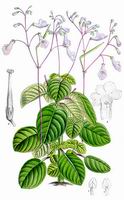 |
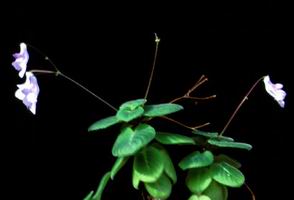 |
Streptocarpus kirkii Hook.f.
Left: Bot. Mag. t. 6782 (1884) |
Streptocarpus subg. Streptocarpus - rosulate species
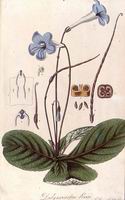 |
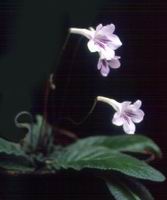 |
Streptocarpus rexii Lindl. (type species
of genus and subgenus Streptocarpus)
Left: Hook., Exotic Flora 3: t. 227 (1827), as Didymocarpus rexii |
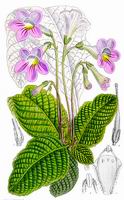 |
Streptocarpus cyaneus S.Moore
Bot. Mag. t. 8521 (1913) |
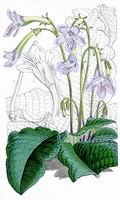 |
Streptocarpus gardenii Hook.
Bot. Mag. t. 4862 (1855), orig. illustration |
Streptocarpus subg. Streptocarpus - unifoliate species
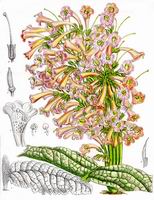
|
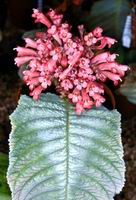
|
Streptocarpus dunnii Mast.
Left:
Bot. Mag. t. 6903 (1886)
|
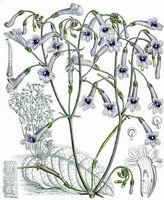 |
Streptocarpus grandis N.E.Br.
Bot. Mag. t. 8042 (1905), orig. illustration |
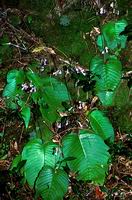
|
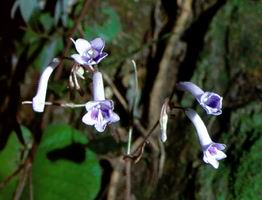
|
Streptocarpus grandis N.E.Br.
S Africa, Ngoye forest, phot. A. Weber (1979) |
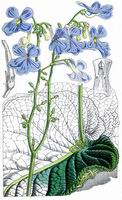 |
Streptocarpus polyanthus Hook.
Bot. Mag. t. 4850 (1855), orig. illustration |
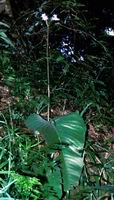 |
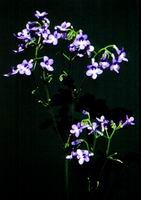 |
Streptocarpus wendlandii Hort.
Dammann
S Africa, Ngoye forest, phot. A. Weber (1979) |
last modified: 2007-07-13